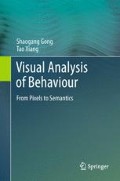Abstract
Given a large quantity of unprocessed videos of object activities, the goal of automatic behaviour profiling is to learn a model that is capable of detecting unseen abnormal behaviour patterns whilst recognising novel instances of expected normal behaviour patterns. In this context, an anomaly is defined as an atypical behaviour pattern that is not represented by sufficient examples in previous observations. Behaviour profiling is by unsupervised learning and anomaly detection is treated as a binary classification problem. One of the main challenges for a binary classification model is to differentiate a true anomaly from outliers that give false positives. In this chapter, we consider a clustering model that discovers the intrinsic grouping of behaviour patterns. The method does not require manual data labelling for either feature extraction or discovery of grouping. This is crucial because manual labelling of behaviour patterns is often impractical given the vast amount of video data, and is subject to inconsistency and error prone. The method performs incremental learning to cope with changes of behavioural context. It also detects anomalies on-line so that (a decision on whether a behaviour pattern is normal is made as soon as sufficient visual evidence is collected without the completion of the observed pattern.
Access this chapter
Tax calculation will be finalised at checkout
Purchases are for personal use only
Notes
- 1.
The largest eigenvectors are eigenvectors with largest eigenvalues in magnitude.
References
Altman, D.G., Bland, J.M.: Diagnostic tests 1: sensitivity and specificity. Br. Med. J. 308(6943), 1552 (1994)
Berger, J.: Statistical Decision Theory and Bayesian Analysis. Springer, Berlin (1995)
Bernstein, A., Mannor, S., Shimkin, N.: Online classification with specificity constraints. In: Advances in Neural Information Processing Systems, Vancouver, Canada, December 2010
Bishop, C.M.: Pattern Recognition and Machine Learning. Springer, Berlin (2006)
Dempster, A.P., Laird, N.M., Rubin, D.B.: Maximum likelihood from incomplete data via the EM algorithm. J. R. Stat. Soc. 39(1), 1–38 (1977)
Higgins, A., Bahler, L., Porter, J.: Speaker verification using randomized phrase prompting. Digit. Signal Process. 1, 89–106 (1991)
Kruskal, J.B., Liberman, M.: The Symmetric Time-warping Problem: From Continuous to Discrete. In: Sankoff, D., Kruskal, J. (eds.) Time Warps, String Edits, and Macromolecules: The Theory and Practice of Sequence Comparison, pp. 125–161. CSLI Publications, Standford (1983)
Neal, R., Hinton, G.: A view of the EM algorithm that justifies incremental, sparse, and other variants. In: Jordan, M.I. (ed.) Learning in Graphical Models. Kluwer Academic, Dordrecht (1998)
Ng, A.Y., Jordan, M.I., Weiss, Y.: On spectral clustering: analysis and an algorithm. In: Advances in Neural Information Processing Systems, Vancouver, Canada, December 2001, pp. 849–856 (2001)
Ng, J., Gong, S.: Learning intrinsic video content using Levenshtein distance in graph partition. In: European Conference on Computer Vision, Copenhagen, Denmark, May 2002, pp. 670–684 (2002)
Rabiner, L.R.: A tutorial on hidden Markov models and selected applications in speech recognition. Proc. IEEE 77(2), 257–286 (1989)
Roberts, S., Husmeier, D., Rezek, I., Penny, W.: Bayesian approaches to Gaussian mixture modelling. IEEE Trans. Pattern Anal. Mach. Intell. 20(11), 1133–1142 (1998)
Shan, Y., Sawhney, H.S., Pope, A.: Measuring the similarity of two image sequence. In: Asian Conference on Computer Vision, Jeju, Korea, January 2004
Shi, J., Malik, J.: Normalized cuts and image segmentation. IEEE Trans. Pattern Anal. Mach. Intell. 22(8), 888–905 (2000)
Weiss, Y.: Segmentation using eigenvectors: a unifying view. In: IEEE International Conference on Computer Vision, Corfu, Greece, pp. 975–982 (1999)
Wilpon, J., Rabiner, L.R., Lee, C., Goldman, E.: Automatic recognition of keywords in unconstrained speech using hidden Markov models. IEEE Trans. Acoust. Speech Signal Process. 38(11), 1870–1878 (1990)
Xiang, T., Gong, S.: Incremental and adaptive abnormal behaviour detection. Comput. Vis. Image Underst. 111(1), 59–73 (2008a)
Xiang, T., Gong, S.: Video behaviour profiling for anomaly detection. IEEE Trans. Pattern Anal. Mach. Intell. 30(5), 893–908 (2008b)
Zweig, M.H., Campbell, G.: Receiver-operating characteristic (ROC) plots: a fundamental evaluation tool in clinical medicine. Clin. Chem. 39(8), 561–577 (1993)
Author information
Authors and Affiliations
Corresponding author
Rights and permissions
Copyright information
© 2011 Springer-Verlag London Limited
About this chapter
Cite this chapter
Gong, S., Xiang, T. (2011). Unsupervised Behaviour Profiling. In: Visual Analysis of Behaviour. Springer, London. https://doi.org/10.1007/978-0-85729-670-2_8
Download citation
DOI: https://doi.org/10.1007/978-0-85729-670-2_8
Publisher Name: Springer, London
Print ISBN: 978-0-85729-669-6
Online ISBN: 978-0-85729-670-2
eBook Packages: Computer ScienceComputer Science (R0)

